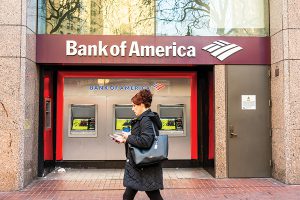Bloomberg
Bank of America Corp (BofA) reported its highest quarterly net interest income (NII) in at least a decade as the lender reaps the benefits of the Federal Reserve’s interest-rate hikes, and debt traders beat analysts’ estimates.
NII, a key source of revenue for the bank, rises 24% to $13.8 billion in the third quarter on higher rates and loan growth. Analysts had expected a roughly 23% increase for NII, the revenue the bank collects from loan payments minus what it pays depositors. Higher loan revenue combined with an increase in trading revenue helped earnings beat analysts’ expectations.
“We continued to see strong organic client growth across our businesses, with increased client activity helping to drive revenue up by 8%,†Chief Executive Officer Brian Moynihan said in a statement.
The lender’s non-interest expenses rose 6% from a year earlier to $15.3 billion. Costs have been a focal point for investors this year after executives said they expect them to drop in future quarters.
The bank’s traders beat estimates, with bond-trading revenue rising 27% to $2.55 billion and equity trading down 4% to $1.54 billion. The third quarter saw dramatic market swings tied to interest-rate hikes, surging inflation, recession fears and Russia’s war in Ukraine.
The results offer another look at how Wall Street fared through a choppy quarter marked by consumer strength, capital-markets weakness and a gloomy economic outlook. Last week, JPMorgan Chase & Co., Morgan Stanley, Citigroup Inc. and Wells Fargo & Co. all posted gains in net interest income, with some raising their NII forecasts for the rest of the year.
Investment-banking revenue fell 46%, better than the 47% drop analysts were expecting, as the same market tumult that drove trading up also led to muted dealmaking. Fees for advising on mergers and acquisitions declined 34%, and revenue from equity and debt issuance dropped 76% and 34%, respectively.
The company’s loan balances rose to $1.03 trillion at the end of the third quarter, up 12% from a year earlier and slightly less than analysts’ estimates of roughly $1.04 trillion. Lending has been a key focus for investors, with government-stimulus payments undercutting borrowing by companies and consumers during the pandemic, and rising interest rates making loans costlier.
 The Gulf Time Newspaper One of the finest business newspapers in the UAE brought to you by our professional writers and editors.
The Gulf Time Newspaper One of the finest business newspapers in the UAE brought to you by our professional writers and editors.
